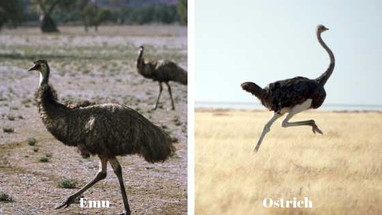Aug 8th 2019
What's the Difference Between an Emu and an Ostrich?
What's the Difference Between an Emu and an Ostrich?
Ostriches (below) and emus (above) are both members of the ratite group of large, flightless birds that are scattered throughout the Southern Hemisphere, including Africa (the ostrich’s range) and Australia (the emu’s range).
The two animals share many physical characteristics, such as broad eyes; an elongated, featherless neck; long, strong legs that burst into explosive speeds when on the run; long, dagger-like claws at the end of their feet (which they use vigorously to defend themselves); underdeveloped breast muscles; retrogressed flight feathers; and prominent wings that are used not for flight, but for courtship. Additionally, the males and females of both species are polygamous, and their eggs’ shells have a thickness so great that the hatchlings develop more rapidly than any other bird.
But the two birds also have differences in terms of size, ecology, and behavior. Although emus are the largest birds in Australia (weighing around 80 to 90 pounds apiece), they're considered pretty small when compared to a fully grown ostrich, which is the largest bird on Earth (they're about three times the size of an emu, weighing around 220 to 265 pounds). While emus are mostly omnivores, feeding on plants as well as invertebrates like spiders and scorpions, ostriches tend to develop a strictly herbivorous diet (though they may eat insects).
Moreover, emus have three toes on their feet while ostriches possess two toes plus a long tendon that allows them to run at speeds of up to nearly 45 mph, whereas emus generally top out at 30 mph. Lastly, the emu is sometimes considered more docile toward humans than the ostrich.
Still, despite their differences, emus and ostriches do have similarities, and so they remain tangentially related to each other, since they are both flightless birds that are part of the ratite group as mentioned earlier. Which practically makes them cousins.

